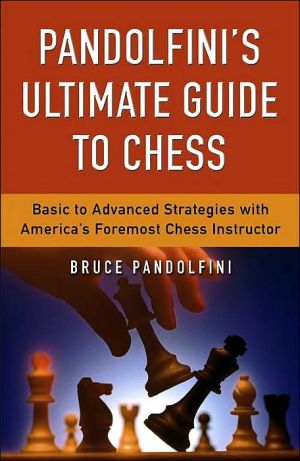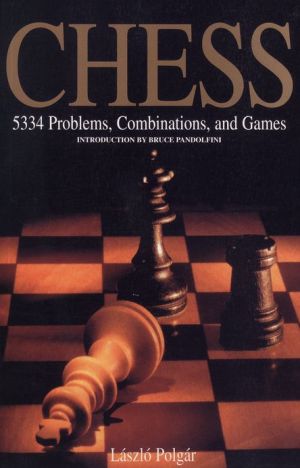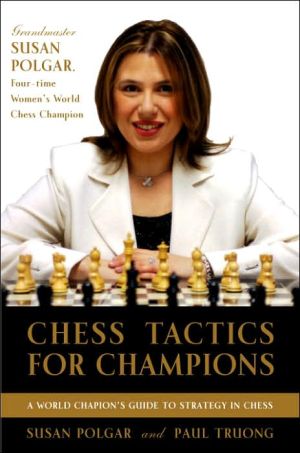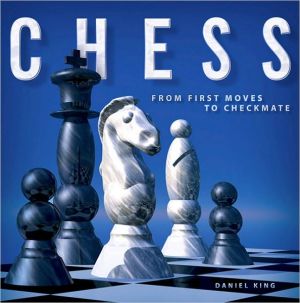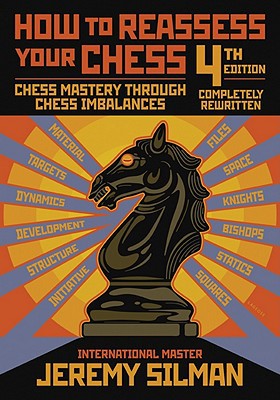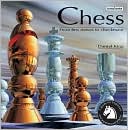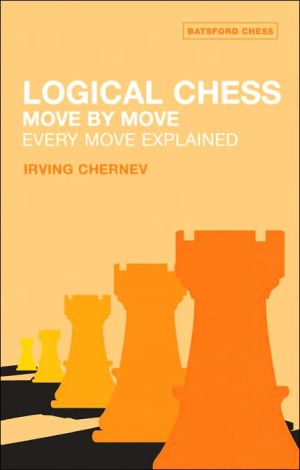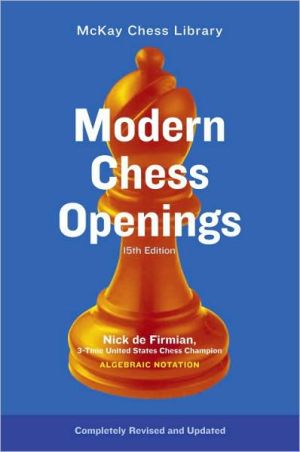Pandolfini's Ultimate Guide to Chess: Basic to Advanced Strategies with America's Foremost Chess Instructor
From America's foremost chess teacher and author comes a new standard: a comprehensive course covering all aspects of the game, to improve your technique whether you are a newcomer or a longtime fan.\ One of America's best-known chess masters, Bruce Pandolfini has helped millions learn the intricacies of chess through his acclaimed books and workshops. In this exciting volume, he presents a complete overview of the entire game and its culture. Structured as a dialogue between a beginning...
Search in google:
From America's foremost chess teacher and author comes a new standard: a comprehensive course covering all aspects of the game, to improve your technique whether you are a newcomer or a longtime fan.One of America's best-known chess masters, Bruce Pandolfini has helped millions learn the intricacies of chess through his acclaimed books and workshops. In this exciting volume, he presents a complete overview of the entire game and its culture. Structured as a dialogue between a beginning student and an expert teacher, Pandolfini's Ultimate Guide to Chess takes the student step-by-step from fundamentals to advanced, highly strategic play. Combining easy-to-follow diagrams with trenchant and up-to-date analysis, Pandolfini puts a new twist on accepted chess theory, offering a seamless beginning-to-end approach, including: • a short introductory history of the game• the moves, rules, and contemporary notation forms• the basic principles of chess• how to develop an opening repertoire• the art of tactical play• pattern recognition and memory aids• traps and pitfalls to be avoided• middlegame play, strategy, and planning• defense and counterattack• transitions to the endgame and the endgame itself• computers and the future of chess• the best websites for playing chess onlineWith Pandolfini's expert insight into the history and modern world of chess, as well as several appendices to enhance play and appreciation, Pandolfini's Ultimate Guide to Chess makes the perfect gift for players of all ages and will be the benchmark titlefor chess players for years to come.
Prologue: Chess, The Universal Game\ Somewhere back in time, human beings invented chess. Ever since, men and women have tried to explain their fascination for, attraction to, even obsession with a checkered board and its symbolic figures. A struggle of will, a contest of intellects, the vicissitudes and intrigue of power relationships, childhood delight, and just plain fun — chess can stand for it all.\ Chess reflects the real world in miniature. Endeavor, struggle, success, and defeat — they are part of each game ever played. Thomas Huxley, the scientist who helped Darwin write the theory of evolution into nineteenth-century philosophy, said: "The rules of the game are what we call the laws of nature. The chessboard is the world" and "The pieces are the phenomena of the universe."\ Ben Franklin, possibly the best American chessplayer of his time, also believed that the chessboard constituted a microcosm of the real world. Studying chess had practical value, he argued. Understanding the moves, rules, and structure of the game encouraged the development and training of essential intellectual skills such as inductive and deductive reasoning, long-term planning, and creative problem-solving. Plenty of present-day educators who have studied the effects of chessplaying on other disciplines have added their approval to Franklin's words. Once again Old Ben was on to something ahead of the pack.\ Chess is more than a game. It's a universal tale of interlocking relationships, layered thinking, analytical drive, and an intuitive sense of how things work. It's mathematical yet musical, logical but theoretical. It can be art or sport, contest or dream, fantasy or reality. Whatever the game's ultimate significance, perhaps you've picked up this book hoping to go beyond the moves and rules to exploring some of the game's aura and seductive mystery.\ What better way to learn the universal game than through a universal learning process? Almost as soon as a child begins to talk, it starts asking questions, many unanswerable. In this book, a teacher uses Socratic methods to reveal the fundamentals of chess interactively, in give-and-take conversations with a rather challenging student. We learn through their question-and-answer sessions. Their debates over chessic possibilities make up the chapters. And each chapter constitutes an actual chess lesson — on the game's moves and rules; on opening, middlegame, and endgame structure; on principles, tactics, and strategy; and on anything else germane to the improvement of chess skill that might come up.\ Since we learn best by doing, the teacher in this book illustrates chess essentials by using an instructionally created but perfectly natural game. White and Black, teacher and student, discuss their choices and reasoning just as players would if they were going over a real game — by considering options, variations, and possibilities throughout.\ What makes their game different is that it doesn't emphasize the state-of-the-art moves grandmasters play and seldom bother to explain. Rather, it includes a normal mixture of good, reasonable, and even bad moves that inexperienced players are likely to consider. Furthermore, the moves and their respective variations, though shown in clear diagrams that everyone can understand, are also expressed conversationally, in asides and as thoughts seem pertinent. That's just the way players converse about chess in any country of the world. To avoid confusion from the real game's moves and their analytic alternates, boldface is used for actual moves, and ordinary type for moves that are possible but not played.\ Most introductory chess books offer lofty principles, presenting them as if they're inviolable absolutes in a grand narrative. But those learning the game naturally have many questions about the other side of things, when particular principles don't apply and the story takes unexpected twists and turns.\ Pandolfini's Ultimate Guide to Chess offers an abundance of principles, but it also devotes time to their exceptions and subtle colors — the very things that make the game and those who play it distinctive. Furthermore, because we're dealing directly with principles and their exceptions, our teacher and student may take a second or even a third look at an idea throughout the course of the game. No lesson is wholly and completely digested in one try anyway, and the flow of the book's discourse reproduces this reality. Repetition is a crucial part of typical learning, and this text aims to capture the natural feel of the learning process. To this end, the dialogue includes the constant use of instructional reinforcement, as well as the sort of typical banter and lighter moments integral to the interactive exchange of question-and-answer learning.\ This book partially draws on ideas in my earlier publications. But over time, experience teaches us how to compose more precise formulations and more effective presentations. Pandolfini's Ultimate Guide to Chess uses an innovative framework to show you exactly what you need to know in order to un-derstand how chess is played, and how it ought to be played. Reading it should help equip you with the tools required to play and enjoy a challenging game of chess, even if you're starting from a position of knowing relatively nothing about pawns or society's metaphors for them. As you absorb specific chessic knowledge, you'll acquaint yourself with valuable analytic weapons that can be used to sharpen your approach, not only for playing chess, but for any intellectual endeavor whatsoever.\ While you're luxuriating in the joy of pure mental stimulation, perhaps even learning how to beat someone you've never quite been able to beat before, you might also pick up on something else: how not to beat yourself. How many games can offer all this and be as rewarding as all that?\ Copyright © 2003 by Bruce Pandolfini
ContentsPrologue: Chess, The Universal GameLesson 1: In the BeginningThe Moves and RulesLesson 2: Arming for AttackNon-mating TacticsLesson 3: Defining the GoalMating PatternsLesson 4: Terms of EngagementThe ElementsLesson 5: Staking out TerritoryOpening Principles and the First MoveLesson 6: Establishing the Neutral ZoneBlack's ResponseLesson 7: Determining PrioritiesDevelopment and the CenterLesson 8: Starting the CampaignComparing Minor PiecesLesson 9: Digging the TrenchesTrades, Pins, and More on Minor PiecesLesson 10: Accumulating AdvantagesPawn Play and WeaknessesLesson 11: Forming PlansDoubled Pawns, Castling, and Open LinesLesson 12: Evaluating and CalculatingThe Middlegame, Exchange Values, How to AnalyzeLesson 13: Breaking ThroughStrategy and Tactics, the Importance of Material, Avoiding ErrorsLesson 14: The Beginning of the EndEndgame Principles, Centralization, the Active King, and Pawn PromotionLesson 15: Approaching the GoalThe Passed Pawn and Pawn MajoritiesLesson 16: All Good Things Come to an EndThe Seventh Rank, Invasion, and SimplificationEpilogue: Chess = mc2Appendix 1: GlossaryAppendix 2: Opening MovesAppendix 3: Chess on the WebAppendix 4: World ChampionsAppendix 5: Significant Dates in Chess HistoryAppendix 6: QuotesAppendix 7: Chess in Movies and BooksAppendix 8: The Most Famous Chess Game of AllTimeBibliographyIndexAcknowledgments
